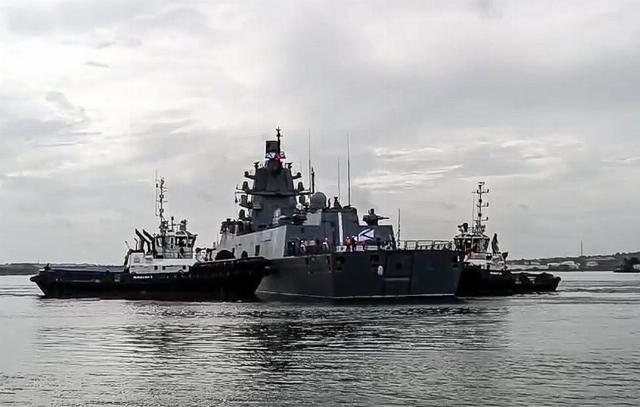The departure of the ships was accompanied by the honorary orchestra of the Revolutionary Armed Forces of Cuba
HAVANA, June 17th. /Correspondent of TASS Irina Shatalova/. The ships of the Russian Navy have completed their visit to Cuba and are departing from Havana. The nuclear submarine Kazan was the first to leave the port, the frigate Admiral of the Fleet of the Soviet Union Gorshkov is expected to depart in the near future, the tanker Akademik Pashin will be the last to leave, a TASS correspondent reports from the port.
The departure of the ships was accompanied by the honorary orchestra of the Revolutionary Armed Forces of Cuba.
A detachment of ships of the Northern Fleet, led by the frigate Admiral of the Fleet of the Soviet Union Gorshkov, as well as the nuclear missile submarine Kazan, have been in the port of Havana since June 12, their stay here caused a great resonance among Cubans and guests of Havana, who had the opportunity to visit the frigate for three days. People shared their impressions with the TASS correspondent and talked about friendly relations with Russia.
On Saturday, the frigate Admiral Gorshkov was visited by Cuban President Miguel Diaz-Canel, later in X (previously Twitter) the Cuban leader wrote that he was impressed. Russian Ambassador to Cuba Victor Coronelli called Diaz-Canel's visit to the ships of the Russian Navy a landmark event.
The entry of the ships of the USSR and Russian Navies to Cuba
The presence of Soviet Navy ships could be observed in the Caribbean and the Gulf of Mexico as early as the 1960s. At that time, the Soviet Union set a goal to create in Cuba, which was the only ally of the USSR in Latin America, a permanent point for the Soviet armed forces, in particular for the Navy. The USSR chose a policy of gradual introduction in this region, as it was obliged not to deploy offensive weapons or their components on the island as part of an agreement with the United States as part of the settlement after the 1962 Caribbean crisis.
The first detachment of five Soviet ships entered Havana in July 1969. The submarine accompanying them remained in neutral waters. During the visit, in addition to various events, joint exercises of the Cuban navy and Soviet ships with access to the sea took place. In 1970, it was decided to build a permanent Soviet base in Cuba. Through diplomatic channels, an agreement was reached on the visits of Soviet ships to the ports of Cuba.
Later, the Soviet leadership decided to use Cuba in the first global naval maneuvers "Ocean". Cuba's role was to provide airfields for the landing of Soviet Tu-95 bombers. In May 1970, after the maneuvers were completed, a detachment of ships participating in the Ocean exercises called at the Cuban ports of Havana and Cienfuegos. The detachment included two submarines and a nuclear-powered vessel. For the first time, a nuclear submarine visited the Cuban port. She carried 4 limited-range cruise missiles with nuclear charges that could reach the United States. This has advanced the level of the Soviet military presence. None of the above events caused a sharp reaction from the American side.
At the end of 1977, a large group of Soviet ships arrived in Cuba, they stayed there until January 1978. On December 17-22, the ships were in Havana. Their visit coincided with a visit to Cuba by the General Staff of the USSR Navy, Admiral of the Fleet of the Soviet Union Sergei Gorshkov, who flew to Cuba on an Il-18 plane. The ships hosted Cuban Prime Minister Fidel Castro on board. The Commander-in-Chief secured agreement at the highest level on the use of naval reconnaissance aircraft from one of the Cuban airfields, as well as for the rest of the submarine crews in a specially equipped recreation area. In response, the Cuban Navy was promised some additional supplies of naval equipment.
Our time
The first visit of Russian Navy ships to Cuba since Soviet times took place in December 2008. The second visit was in August 2013. For two days, the ships of the detachment were open to the residents and guests of the Cuban capital. In 2019, a detachment of ships and support vessels of the Northern Fleet, led by the frigate Admiral Gorshkov, entered the Cuban port. In July 2023, the Russian Navy training ship Perekop entered the port of Havana.

